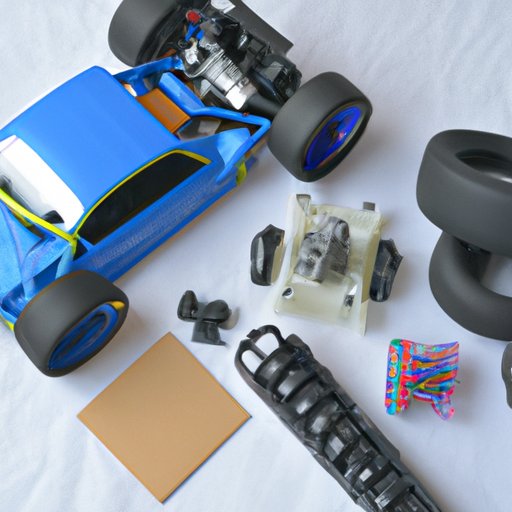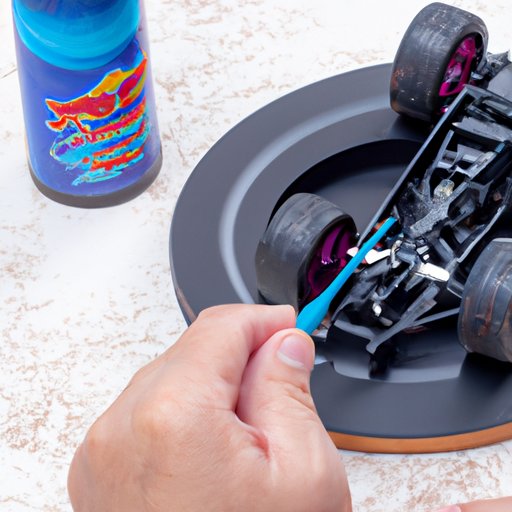Introduction
RC (radio-controlled) drift cars are miniature vehicles that allow users to experience the thrill of drifting without having to go to a professional track. They are powered by electric motors and can be customized with various body kits, wheels, and tires. Building a RC drift car at home is a great way to get creative and have fun while learning about electronics and mechanics.
Step-by-Step Guide to Building a RC Drift Car at Home
Building a RC drift car from scratch requires some knowledge of electronics and mechanics, but with the right parts and tools, anyone can do it. Here is a step-by-step guide to get started:
Gathering the Necessary Parts
The first step in building a RC drift car is to gather all the necessary parts. You will need a chassis, motor, ESC (electronic speed controller), servo, wheels, tires, battery, and body kit. All of these parts should be compatible with each other. If you are unsure of what parts to get, consult with an experienced RC driver or a hobby shop.
Assembling the Chassis
Once you have all the necessary parts, the next step is to assemble the chassis. Start by attaching the motor and ESC to the chassis using the screws provided. Next, attach the servo and connect it to the motor and ESC. Finally, install the wheels and tires.
Connecting the Electronics
After the chassis is assembled, it’s time to connect the electronics. Connect the battery to the ESC and then to the motor. Make sure all the connections are secure and there is no exposed wiring. Once everything is connected properly, it’s time to test the motor and servo.
Adding the Body Kit
Once the electronics are connected, it’s time to add the body kit. This is where you can get creative and customize the look of your RC drift car. There are many body kits available, so take your time and find one that suits your style. After the body kit is attached, you can add decals and other accessories.
Finishing Touches
Finally, it’s time to put on the finishing touches. Add any additional accessories such as lights, spoilers, and exhaust pipes. Once everything is in place, you’re ready to hit the track!
The Basics of RC Drift Cars: What You Need to Know Before Building Your Own
Before you start building your own RC drift car, it’s important to understand the basics. Here are some things to consider when selecting parts for your DIY RC drift car:
Understanding Different Types of Motors
RC drift cars use either brushed or brushless motors. Brushed motors are cheaper and easier to maintain, but they don’t last as long as brushless motors. Brushless motors are more powerful, but they require more maintenance and cost more money.
Choosing the Right Wheels and Tires
Wheels and tires play an important role in how your RC drift car performs. Look for wheels and tires that provide good traction and grip on the track. Also, make sure they are compatible with your motor and ESC.
Finding the Right Battery
The battery is the heart of your RC drift car. Make sure to get a high-quality battery that is compatible with your motor and ESC. Batteries come in different sizes and capacities, so choose one that fits your needs.

How to Choose the Right Parts for Your DIY RC Drift Car
When it comes to building a RC drift car, it’s important to choose the right parts. Here are some tips to help you find the best parts for your project:
Researching Different Brands and Models
Take your time and research different brands and models of RC drift cars. Read reviews and compare prices to find the best parts for your budget. Don’t be afraid to ask questions and consult with experts.
Looking for Quality Parts at Affordable Prices
It can be tempting to buy the cheapest parts available, but this is not always the best option. Instead, look for quality parts that fit your budget. Quality parts will last longer and give you better performance on the track.
Consulting with Experts
If you are still unsure of which parts to get, consult with an experienced RC driver or a hobby shop. They can provide valuable advice and help you find the best parts for your project.

Tips and Tricks for Making a RC Drift Car at Home
Here are some tips and tricks to keep in mind when building a RC drift car at home:
Test Driving Before Racing
Before taking your RC drift car to the track, make sure to test drive it. This will give you an idea of how it handles and if any adjustments need to be made. It’s better to make any necessary changes before racing to ensure a smooth ride.
Caring for Your RC Drift Car
To keep your RC drift car running smoothly, make sure to clean it regularly. Wipe down all the components with a cloth and check for any loose connections or broken parts. Make sure to store your RC drift car in a safe place when it’s not in use.
Learning From Other RC Drivers
Finally, don’t be afraid to ask questions or seek advice from other RC drivers. They can provide valuable tips and tricks that will help you become a better RC driver. Learning from others is a great way to improve your skills and have more fun.
A Beginner’s Guide to Assembling a RC Drift Car From Scratch
Assembling a RC drift car from scratch can seem like a daunting task, but with the right tools and supplies, anyone can do it. Here are some tips to help beginners get started:
Acquiring the Necessary Tools and Supplies
The first step is to acquire all the necessary tools and supplies. You will need a soldering iron, screwdrivers, pliers, and wire cutters. Additionally, you will need screws, nuts, bolts, and washers to assemble the parts. Make sure to have all the necessary tools and supplies before starting.
Following Instructions Carefully
Once you have all the necessary tools and supplies, carefully follow the instructions provided with the parts. Each part is designed differently, so make sure to read the instructions carefully and pay attention to the details. This will ensure that your RC drift car is assembled correctly.
Troubleshooting Common Issues
If you encounter any issues during the assembly process, don’t hesitate to reach out for help. Consult with an experienced RC driver or hobby shop for troubleshooting advice. With the right guidance, you can get your RC drift car up and running in no time.
Conclusion
Building a RC drift car at home is a great way to learn about electronics and mechanics while having fun. This guide has taken you through the steps for building a RC drift car from scratch, including gathering parts, connecting electronics, and adding body kits. With the right tools and supplies, anyone can assemble their own RC drift car. So why not get started today?
(Note: Is this article not meeting your expectations? Do you have knowledge or insights to share? Unlock new opportunities and expand your reach by joining our authors team. Click Registration to join us and share your expertise with our readers.)
